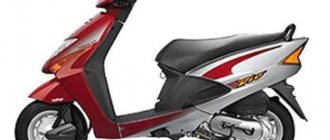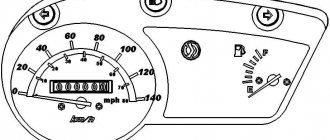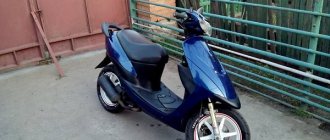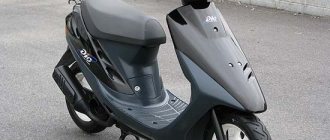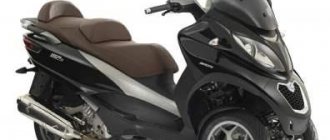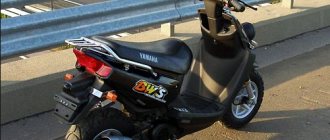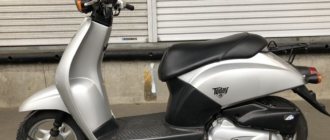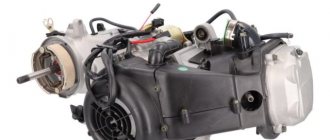Specifications
A scooter bike has the body of a motorcycle. The model is equipped with a gasoline engine, the recommended fuel type is AI-95. Number of cylinders: 1. The fuel system operates via a carburetor. The engine can be started using an electric starter or a kick starter. The operation of the power unit remains stable throughout the entire trip due to the liquid cooling system. The gearbox is an automatic mechanism with a variator, the main gear is a belt. The scooter weighs 103 kg. The fuel tank holds 7 liters of fuel. The design of the Italian scooter is based on a steel tubular frame. Standard tire sizes are 120/70-14 (front) and 140/60-13 (rear). General (overall) dimensions: length 1840 mm; width 750 mm; The exhaust system consists of a muffler.
Season with pepper
The scooter, which had not changed for eight years, certainly needed modernization, and even “treatment” of some “childhood diseases”. And in 2005, Gilera introduced an updated Runner line with engines of 50 and 125 cc, and at the beginning of the next year a 200 cc model. The appearance of the device has been completely changed. Not everyone liked the stylistic decision of the look: some (avid lighters) recognized it as “never sporty”, others (sedate men) on the contrary liked it. As they say, “taste and color”. What's new in technical stuffing? Yes, almost everything! First of all, the power unit. Instead of an evil two-stroke, they stuck in a Piaggio Leader engine with a capacity of 198 cc. Its features include a fairly high degree of boost and a four-valve cylinder head. Everything works to deliver power over a wide rpm range. And it is not small - 21 hp, and peak torque - 17 N.m.
The modernization also affected the steel duplex frame: its torsional rigidity has increased. The fuel tank is located in the tunnel between the driver’s legs, thereby lowering the center of gravity. The designers modified the engine-to-frame mounting unit (on the old model, the silent blocks quickly wore out and the engine-transmission unit was distorted).
But the device that came to us for testing is not in stock configuration - and here the interesting thing begins, which confirms: the 4T has great potential and is capable of carrying no worse than a two-stroke. Instead of a standard muffler, our tuned scooter is equipped with a forward flow, Malossi variator, a tuning clutch and a switch without a limiter. Do you suspect that this is not enough to bring it to the level of capabilities of a “two-stroke”? I thought so too until I took it for a ride.
I press the starter button - and the silence of the courtyard exploded with a loud bang, and it was replaced by the guttural gurgling of the Scorpion “can”. Growling, the engine reached warm-up speeds. How not to play with the throttle! From a distance the sound is similar to an endury bike; you won’t immediately understand that it’s a scooter growling. I spun the engine to maximum speed a couple of times and heard a “shot” from the muffler, accompanied by a fireworks display of escaping flames. Like in “sports”!
Oh! I just wanted to slowly turn around in the courtyard - and I almost got stuck in the fence: the engine “tears” from the very bottom. To evaluate the dynamic and speed capabilities of the car, I went onto the freeway - on it you can turn it all the way up. And here’s what I’ll say after I unscrewed it. The maximum speed (according to the speedometer) was 150 km/h! Compare: the stock “maximum speed” is 120. Acceleration from a standstill will seem shocking to an inexperienced scooter rider. This is thanks to the sports clutch: the scooter shoots like lightning. Most likely, the two-stroke version (pretty pumped up) will probably outperform the VXR200, but not by much - it feels like they are equal in dynamics. I can’t help but note that the Piaggio Leader engine has significantly more torque at low and medium speeds, and the torque curve is flatter, while the “smoke”* spins up and begins to “live” only at high speeds. Therefore, the “fat” torque of the VXR200 at the “bottoms”, coupled with the variator tuned for a dynamic start, compensates for the lack of peak “horses” in the overall “herd”. There is another advantage of the four-stroke power plant: the scooter starts off smoothly, without consumptive jerks.
Cornering at speeds (over 100 km/h) also left a pleasant impression. The reinforced frame does not “play”, the scooter takes turns, the S-shaped ligaments are flexible and “without hesitation”. Partly due to the fact that the center of gravity is shifted downwards (remember, the gas tank is in the tunnel?). But Runner is not a lightweight person, and on the old model it was necessary to make a fair effort to keep within the trajectory of turns.
...And you know, after hundreds of kilometers you somehow forget about the intricacies of the technical stuff - you just enjoy the movement. When you stop, you take pleasure in “licking” the outlines, which show the design influence of Nexus, until recently the flagship of the scooter line - you say to yourself and, illuminating the way with a xenon headlight, you are carried away into the space of the night city...
Appearance and Design
This is definitely one of the best scooters that immediately captivates with its appearance. The designers made every effort to give the scooter more aggression and a sporty bent. Also, the appearance meets all the norms and standards of our time, as evidenced by the smooth shapes and lines of this model. Plastic completely “masks” the engine, components and parts of the scooter. From the front, the headlight, consisting of special lenses, immediately catches your eye. Thanks to the high developments of Italian engineers and designers, lighting equipment illuminates the road in the best possible way in the evening, which is important in city driving conditions. Also noticeable are side mirrors, a small fairing and leg protection that protects the driver from damage during falls.
The seat is pleasant to the body, with a thick layer of soft filling. It can comfortably accommodate two people. The wheels are “covered” by modern rear and front fenders.
Fly in the ointment: review of the Gilera Runner VXR 200cc 2006 scooter
We all know that landing in a two-wheeled vehicle (I’m talking about convenience) is very important, especially if we are talking about a sports version, and not a stupid “stool” driving only in the right lane with a maximum speed of 55 km/h and acceleration like at the turtle.
Seat
So, about sitting on the 2006/08 Gilera Runner VXR 200. Any sports seat on two-wheeled vehicles, even on a bicycle, is always narrow, tapered towards the top. This makes it more convenient to shift the center of gravity from one side to the other when cornering and a feeling of unity with the vehicle you are sitting on. You feel it with the larger surface of your body, not only with your buttocks, but also with your inner thigh. The Runner VXR 200 has a hint of sportiness throughout, but not in the seat, which looks more like a sloth's toilet.
Let me explain. Take a classic chopper seat and a sportbike seat. Did you catch the difference? In a chaperon saddle you sit inside it, and in sports you sit on it. That’s why “tourists” mean a quiet ride, that is, I dropped the soft seat into the wide, concave seat and slowly rolled away. The “runner” has the same problem: the seat is so flat and deep that you have to adjust for aggressive driving.
There is a luggage compartment under the driver's seat, and a battery under the passenger seat. Everything seems to be fine, but the saddle is solid, like on ordinary city motorcycles. There is no separation between passenger and driver, it is one. Because of this, when you open the seat, it sticks out so high that it always falls down and closes. Once opened, you always have to hold it with your hand or shoulder. If it had been divided into two seats according to modern sports standards, this problem would not have arisen. There is no need to get into the battery every time you open the seat.
Suppose you need to carry a small load. You take the net and, throwing it over your luggage, attach it to the passenger handles (a standard procedure for any motorcycle). Then you remember that you forgot something in the trunk and want to open it, but it won’t work! You again need to unhook the net and remove the luggage, as well as attach it back after you get the thing you need (water, for example). And all because of the “clever guys” from the “Gilera” who did not share the passenger seat with the driver. You can take the Yamaha Aerox or Maxter as a standard for a sporty landing (see photo).
When it’s about thirty degrees outside, riding in motorcycle pants is not the best pleasure; it may only appeal to those who have decided to quickly lose weight. Anyone who has traveled knows. But these are all flowers, absolute hell lies ahead. The 200 cc Gilera Runner engine heats the “toilet” with such force that the water lying in the luggage compartment heats up to 80 degrees! For the sake of experiment, I bought and put a transparent lighter in the trunk. After 15-20 minutes of driving in the heat, the lighter was completely empty. The gas evaporated at this temperature. Now imagine what my soft spot feels like!
But as the weather gets colder, I've really come to appreciate this Italian Dutch oven. The bottom is warm and comfortable, just like in a diaper commercial. Fairy tale! So what is the way out of this situation? It’s either good when it’s cold, or painfully hot when it’s warm. There is no golden mean, like other maxi scooters, where it’s not cold or hot. And this is what I propose. Inside the “toilet” of the Gilera Runner VXR 200 there is a cover for quick access to the engine (without removing the toilet itself). The lid looks like an inverted plate into which streams of hot air from the engine rush. Remove the cover and cut out a square in it for the previously purchased cooler from the computer system unit.
We throw the wires through the switch to the battery, since it is 20 centimeters away. When you're cold, switch or flip the cooler so that warm air blows onto the seat. When it’s hot, on the contrary, let it blow on the engine; in theory, the engine will cool better. The luggage is in the luggage compartment itself and will not wrap around the fan, because computer coolers are protected. Even if my Samodelkin theory turns out to be a failure (which is unlikely), the cut out lid itself will cost 500 rubles, no more. Order a new one. I'll try to bring this idea to life this winter. As soon as I do it, I’ll post a photo report.
Front fork
Everything is standard with her, which is depressing. No, I wouldn't mind a regular fork unless there was a clear alternative. There is no need to reinvent the wheel here, because the exact same model Runner SP 50 FL, which differs from the VXR 200 only in cubic capacity and slight styling, has an INVERTED fork! Unfortunately, it is mechanical, not oil, but after a little modification, the Italian concern Gilera could easily eliminate this oversight. If there is an inverted fork and the traverse fasteners are the same, why not install an inverted fork on all Runner models?
If you still don’t understand the beauty of an inverted fork, here’s an example without the technicalities. Pay attention to what forks are on sportbikes, street bikes and motards. When you see their “feathers”, you will understand how maliciously the “jilers” deprived the two hundred, indeed deprived them, because the fork exists in flow production. You can order your Malossi in a complete set: traverse, stays, brake disc. And although there are not many design changes compared to the stock one on the 200, we can hope that the Malossi is more reliable and will not fail when “stopped” or when jumping from curbs. This pleasure costs 570 euros.
Mirrors
The mirrors on the 2006 Runner VXR 200 are simply terrible (the Italians improved in 2008)! In normal mirrors, the mirror itself is mounted on a hinge and you can easily adjust it with your hands while driving, without resorting to tools. How many of us haven’t experienced a situation where, while making our way through traffic, you caught your mirror on a jeep or gazelle stuck in a traffic jam? Was? But in the 2006 “runner” it is generally extremely difficult to adjust the mirror. You need to stop, take out the hex wrench (do you carry it with you?) and, unscrewing the mirror post, adjust and screw it back. Personally, I never managed to adjust the mirror the first time. It seems like I adjusted it, but then I went and needed to fix it. And unscrew it every time!
Taking a passenger with you, the view in the mirrors changes, and again a small adjustment is needed, because you involuntarily move more towards the steering wheel. Of course, the Italians solved the problem of small adjustments by making the mirror glass in the “burdock” itself movable, but you have to paw it with your hands to adjust it. The amplitude of movement of the glass itself in the “burdock” is so insignificant and ugly that it often returns to its original position, known only to the mirror itself. You can change the mirrors, but the trouble is that the standard freaks hold the plastic of the dashboard fairing (two screws on the bottom and the mirrors are held on top). You will have to install giant washers with rubber gaskets to press the plastic. Carbon F 1, whose name speaks for itself (18 euros) and BGM STYLE GT II (25 euros), can fit in well.
Air filter
Any maxi scooter starting from 150cc (I'm talking about the Japanese, this is my first Italian) has: a variator air filter (foam rubber) and an engine filter (barrel). Moreover, the foam filter is dry, it is not moistened with a special impregnation for air vents, as happens in fifty dollars and all sorts of Chinese, because “Maxi”! It is simply vacuumed or blown with a compressor. But in the Gilera Runner VXR 200 they got it wrong again and use the antediluvian version of NOT a maxi scooter in a maxi. I don’t know what this is and why, just as I don’t understand why there is no filter element in the variator. There is a pipe that sucks air into the variator, it is on the left side under the plastic, but the Italians forgot about the filter.
All dust is blown out by an additional impeller through the lower left part of the variator. The right side sucks in, the left blows out. Everything seems convenient and logical, but all the variator mechanisms are still very dirty, because there is access for dust. I advise you to go to any tire shop and, without removing the variator cover (you can’t remove the cover without an air gun), disconnect the suction pipe, insert a hose with compressed air into it and blow it out. You will immediately find the second hole through the clouds of blown black dust. Blow it out too, the clutch will thank you.
Front and rear brake handles
Not adjustable! When I first sat in the Runner, I discovered that both brake levers were too high. I had to adapt to driving with a broken wrist. Inconvenient, but tolerable. I decided not to suffer and adjust them to suit my driving style. I loosened the hexagon screw and began to turn the handle down. Did not work out. Inside the clamp there is a pin that penetrates the steering wheel itself and does not make it possible to adjust the position of the handle. I have never encountered anything like this before.
I immediately foresee a minus when falling (God forbid, of course). When the steering wheel handle hits the asphalt, the handle may bend or even break off at the socket, in the same place where the locking pin (0.5 mm) is inserted. In the process, this is a conspiracy of Italians who decided to make money on another expensive spare part. Fell - bought a new steering wheel.
Cheap styling
Or rather stickers. The entire Gilera Runner, regardless of cubic capacity, is covered with cheap “Chinese” stickers. They stuck to everything, even the rims, peeling off after a season of use. Making a factory drawing turned out to be not as cool as covering it with cheap stickers from the “Chinese” motorcycle industry. Fortunately, it’s not so difficult to remove this teenage “airbrushing”.
If I made any inaccuracies, please write in a personal message, but the device called Gilera Runner VXR 200 is very good, except for what was described and a few other little things that I don’t want to write about due to their insignificance.
Good luck on the roads and good traffic police officers when you meet. See you on the Mountain.
© metroman
© 2021 Alexander Smirnov, gilerarunner.ru. Spare parts and accessories for Italian motorcycles from Europe. Phone/WhatsApp or email The email address is protected from spambots. Javascript must be enabled in your browser to view the address.
Suspension, braking system
A reliable braking system is the key to safe driving. In this case, the developers installed hydraulic disc brakes with a diameter of 220 mm. At the slightest pressure on the brake handle, the scooter stops moving. During emergency braking, the braking distance is minimal, which is also facilitated by tires with a special tread.
The suspension does not raise any doubts. An almost revolutionary inverted type installation is installed at the front. Depreciation is provided by a telescopic fork. At the rear, a pendulum-type suspension with a monoshock is used. On the Gilera Runner scooter you can easily move on poor quality roads. All potholes are simply not scary for the suspension, whose shock-absorbing qualities are excellent.
